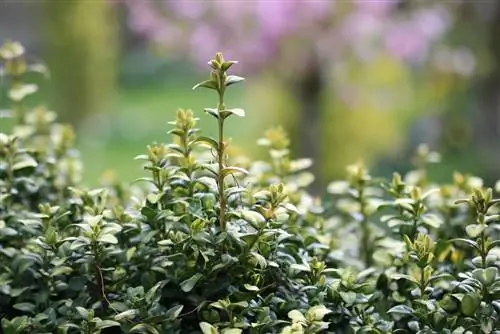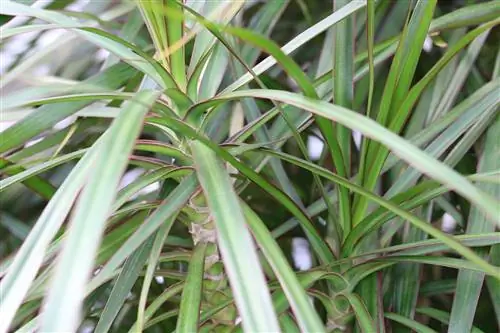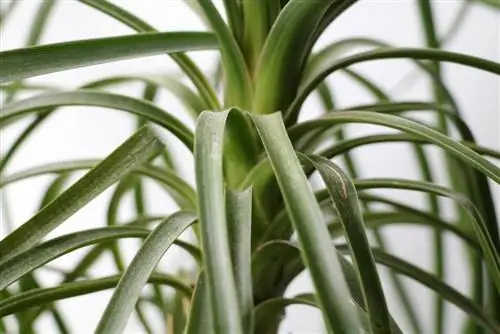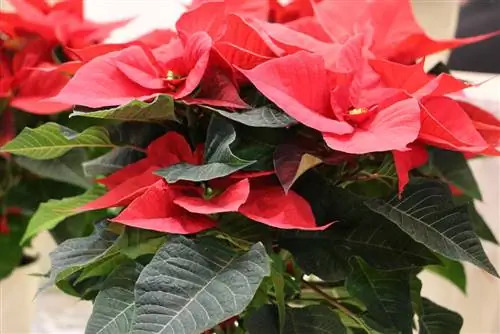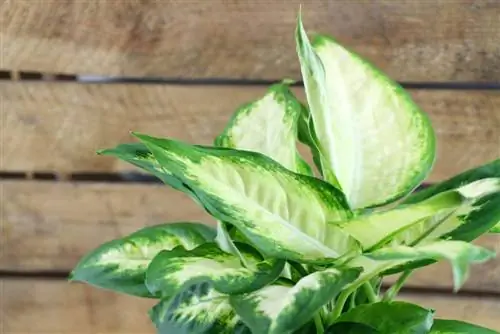- Author admin [email protected].
- Public 2023-12-17 03:39.
- Last modified 2025-01-24 12:45.
Boxwood in the gardens and front gardens or cultivated in pots on terraces or balconies is common in these latitudes. Unfortunately, the evergreen plant is not entirely harmless because the flowers and the young bark contain toxins. If these are ingested through the mouth, they can be dangerous. Therefore, small children and pets are particularly at risk when plant parts are put in their mouths. For adults, however, the danger is relatively low because simply touching them does not lead to poisoning.
Characteristics of boxwood
The boxwood is an evergreen plant that flowers from March to May. It is usually cultivated as a solitary bush or tree and as a hedge plant in home gardens, often in local cemeteries as well as in landscaped parks and green spaces. It is recognized by the following characteristics:
- can grow up to four meters high
- yellow, small flowers
- Leaves are egg-shaped and leathery
- the small, black-brown fruits develop in autumn
Poisonous plant parts
The young bark and flowers of a boxwood tree are particularly poisonous. But the leaves and stems also contain the poison, making it highly poisonous in all parts. It is precisely the cocktail of various poisons that the boxwood contains that makes it so dangerous, especially for children or pets who like to put the leaves or flowers in their mouths. If these parts of the plant that have been put into the mouth are then swallowed, immediate action must be taken. There are up to 70 different alkaloids in the plant, and the following poisons were found in boxwood:
- Buxanine
- Buxtanin
- Bux altin
- Buxpsiin
- as well as the main active ingredient Buxin
Protect children
Box trees can often be found in nearby parks and cemeteries. Therefore, anyone who has small children should always keep an eye on them, even on walks or in the playground. The little ones in particular have fun and think nothing of using the leaves and flowers of plants for a cooking game in the sandpit, for example. They quickly put one or two pieces in their mouths and, in the worst case scenario, swallow them. Therefore, not only should all parents and other guardians be careful if there is a box tree in their own garden, they can also be dangerous for children outside of the home. Therefore, attention should be paid to the following:
- If you have small children, you should avoid box trees in the garden
- place plants cultivated in pots on the terrace or balcony so high that children cannot even reach for them
- When visiting a cemetery, always have the children nearby, there are a lot of box trees here
- in the park or on the playground let your eyes wander to see whether there are box trees in the immediate vicinity of the game
- Older children can be explained which plants are poisonous to them and which are not
- Even smaller children can learn in a playful way from posters which plants they shouldn't touch
- If a new garden is created, make it child-friendly
- all plants that could contain poisons are avoided when growing
Tip:
Children should be made aware of the possible dangers that individual plants can pose early on when they go on a trip into nature or look at their own garden. Nevertheless, parents have to take care of the children, the smaller they are.
Protect pets
Pets also need to be protected from the poisonous boxwood. Cats and dogs should not get near the plant. But the smaller caged animals, such as rabbits or guinea pigs, also like to nibble on all plants and could also get hold of the poisonous leaves of the boxwood. Extreme caution is therefore required here and the following measures can be taken:
- If dogs or cats roam freely in the garden, the boxwood should be fenced high and wide
- For cats, you should also make sure that this is a protection that they cannot climb up
- Allow rabbits, guinea pigs and other caged animals only in an outdoor enclosure that is located far away from poisonous plants
Tip:
Since the flowers and the fruits resulting from them are particularly poisonous, greater care must be taken in the period from April to May and September to October
Symptoms of poisoning in humans and animals

If children, pets or even adults have put parts of the poisonous boxwood in their mouths and possibly even swallowed them, then, depending on the amount of poison ingested, the following symptoms of poisoning can occur:
- Nausea, diarrhea and vomiting
- Dizziness
- Cramps, possibly accompanied by paralysis
- Trembling
- Drop in blood pressure that can end in circulatory collapse
- depending on the amount of poison ingested, in the worst case scenario this can lead to death
- here are the smaller animals first, then the children and finally the adults are at risk
- because the amount consumed is always in relation to size and weight
Tip:
Anyone who discovers that their child or pet has eaten or eaten the poisonous parts should not immediately panic. Usually the amounts are so small that only a few symptoms appear, which disappear after a while as the body breaks down the toxins on its own.
First measures
If a person or pet has been diagnosed with poisoning and it is clear that it comes from the boxwood, the first measure that can be administered is medicinal charcoal, which binds the toxins in the stomach. However, if you are not sure how serious the poisoning is, you should not be afraid to call the human emergency number 112 or the local animal emergency number. Even if the amount of poison ingested was not life-threatening, this provides security.
Tip:
The “Information Center against Poisoning” at the Bochum University Hospital reports on its information page that there are no reports of serious poisoning of parts of the boxwood plant in adults or humans. This means that serious poisonings, even fatal ones, have neither been known nor occurred in humans.
Conclusion
If you have one or more box trees in your garden, you shouldn't panic right away, as they could be harmful to people or animals. Because with the appropriate measures, such as fencing or educating children about poisonous plants, the graceful, evergreen bush does not become a danger in your own garden. But if you have a family with children and pets, you should probably think about making the garden child- and pet-friendly and avoiding all kinds of poisonous plants when planting a new garden.

